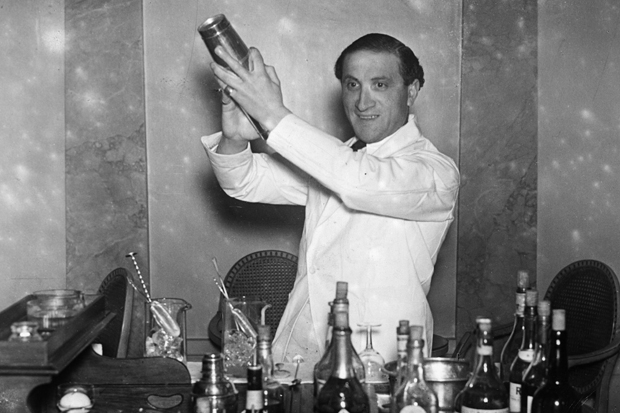We asked our writers to write about their favourite cocktails, from aperitifs to nightcaps, all the way through to the hangover cures. Here’s what they said.
Matthew Parris
The Iron Lady

For years in the 1980s I tried to develop a cocktail to be called the Iron Lady. There were problems: the signifier for iron is really red, while she was clearly blue; and the only blue liqueur I could find was Blue Curaçao. My final prototype consisted in vodka and Blue Curaçao, with a cube of ice impaled by a steel nail (freeze with nail in place, or heat the nail and push it through). It was OK — but the Curaçao was so sweet that you could only use a little, and the whole thing lacked the kick or bite that I think she would have wanted. I feel this is still work-in-progress and would welcome readers’ own proposals. The other way forward is, I suppose, a Bloody Margaret, but she wasn’t a tomato-juice or Tabasco person, and — outside the territories of the Masai — real cattle blood for drinking is hard to procure.
Sam Leith
Martini
I started drinking gin martinis as an affectation. I was stationed in New York as a reporter in 2002 and, intoxicated with the city, wanted to become intoxicated with the city’s drink. I was thinking lunch at the Algonquin.
What began as an affectation became a love affair. ‘Up. Twist.’ Never olives, whose greasy salinity — to my palate — ruins the whole thing. I drank them at Madame X on Houston, Angel’s Share on St Mark’s Place and — especially — Grace on Franklin Street between West Broadway and Church, where they emerged from the gloaming by the long mahogany bar in brimming glasses with tiny ice-crystals bobbing on the surface like the aftermath of a climate-change catastrophe. Also, because in New York they really pour spirits, they were huge. If you embarked on a third you might not remember much about your journey home.
Everyone knows the Dorothy Parker ditty, and the jokes about vermouth minimalisation. The right gin matters: not Bombay, with its overpowering botanicals and its sweetness. And a stemmed, conical glass; though in an emergency you can approximate a very dry one by removing a bottle of Tanqueray from the freezer and swigging from the neck.
Peter Robins
Gin & Tonic

‘So what,’ asked the American, ‘do you put in a gin and tonic?’
‘Um, gin. And tonic?’
It was a students’ Thanksgiving at a shared house in Queens, New York, and I was over from England. It was also my first introduction to just how seriously cocktails can be taken.
My answer was so wrong as to be insulting. Even as simple a drink as a gin and tonic has an ideal form; either I knew it and was lying to conceal it, or I had no business meddling with such mysteries as these.
You could argue that the charm of a G&T is its haphazard generosity; that one must assess how alcoholic the drinker is before deciding how alcoholic the drink will be; that juniper and quinine are such strong, well-matched flavours that it can be surprisingly tricky to divine the proportions, at least until you have a hangover to measure them with. It would all be beside the point. A cocktail is not merely a matter of taste but of tradition and ritual and magic; a culture mixed over ice and decanted into exactly the right glass. I understand that better now. But mine is still probably a gin and tonic.
Sebastian Payne
The Old Fashioned

I first fell in love with the Old Fashioned after a slap-up dinner at Brasserie Zedel in London. I retired to the art deco bar, fancying myself as the Don Draper of Piccadilly Circus. I spotted the Mad Man’s favourite drink on the menu, and plonked some money on the bar. It was expensive.
I found it sour at first, but the Old Fashioned grew on me and now there is never an occasion where it serves me wrong. Crucially, ordering one will always impress your friends. Although it is hard to find in Britain, order one with rye whisky (instead of bourbon) and no ice for the purest experience. Never drink too quickly; it’ll hurt your head.
Johnny Ray
The Negroni
The Negroni is the perfect cocktail in a way that the equally delicious Bloody Mary isn’t. First, its bitter orange sweetness makes it as good after a meal as it is before. Second, the BM needs a plethora of ingredients: tomato juice, vodka, sherry, orange juice, lemon juice, Tabasco, Worcester sauce and celery salt, perhaps even horseradish.
The Negroni, though, needs only gin, sweet red vermouth and Campari, in equal measures. Oh, and ice and a slice of orange. But that’s it. It’s almost impossible to screw up — unlike the aforementioned Bloody Mary, which you order in unknown hostelries at your peril, since they’ll be out of Worcester or Tabasco or celery or something.
With a Negroni, though, you’ll be fine; even the humblest bar will have the requisites. you can also have hours of fun experimenting with different gins and vermouths. And you can substitute Prosecco for gin and get the refreshing Sbagliato. Or swap gin for rum and get a full-on, toffee-rich refueller.
Olivia Cole
Sloegasm
My favourite winter drink is a shot of sloe gin (ideally homemade), topped up in a flute with very cold champagne. It’s criminal to use the really good stuff and Cava works just as well. This drink is apparently called a ‘Sloegasm’. Autumn can be such a grim dark time of year — but you can cheer yourself up by foraging in hedgerows for sloes (which are purple and slightly harder than blueberries). They are supposed to be picked before the first frost, and if you are making your own, the sloe gin should be ready by Christmas. A bright ruby red, there’s something of a pagan rite about the drink.
Sloegasms look and taste best outside — perhaps while shooting, or on a winter picnic. One and a half or perhaps two are delicious: any more than that and you will be sleepy. There’s a wonderful Seamus Heaney poem about sloes: ‘The clear weather of juniper/darkened into winter…,’ he says, describing the gin changing colour with the sloes, ‘I drink to you/ in smoke-mirled, blue-/ black sloes, bitter/ and dependable.’
Mark Mason
The Vesper

‘Three measures of Gordon’s, one of vodka, half a measure of Kina Lillet. Shake it very well until it’s ice-cold, then add a large thin slice of lemon-peel. Got it?’ So says James Bond to a barman in Casino Royale. Later he names the drink after the book’s anti-heroine, Vesper Lynd.
Kina Lillet is no longer made, so instead head to Dukes Hotel in London. They serve their own Vesper in tribute to erstwhile habitué Ian Fleming: three parts No. 3 gin, one part Potocki vodka, half a measure of vermouth (Dukes have their own, ‘Sacred Amber’), all directly from the freezer and finished with a twist of orange. The hotel’s cocktails are legendary for their strength — depending on who you’re with and what happens next, you could end up losing your balance, the price of an impulse buy at Fortnum’s, or your marriage.
Sophia Martelli
The Manhattan
As any fule know, the birthplace and epicentre of all classic cocktails is Manhattan — and I’d say the king of cocktails is the Manhattan. The dark’n’deep Manhattan is a drink for life: you can spend decades tinkering with its elements, or stamp it with your own trademark from the get-go. Built from whisky, vermouth, bitters and garnish, swirled over ice and strained into a glass, there are so many variations it can take a while to settle on a signature mix. My advice is to avoid bourbon — you risk going down the sweet and sickly route — and opt for dry vermouth (or a ‘perfect’ mix of half-Italian, half-French). Good old spicy rye whisky with a twist of lemon is the traditional American approach. I favour a smoky single malt Scotch with Angostura and a maraschino cherry (try Luxardo), a bastardisation known as a Rob Roy that the Zetter Townhouse do a particularly good version of. Once you know your preferred brew, barking your order fast at wait staff is guaranteed to give you a buzz — and the resulting drink is the ultimate test of a bartender.
Jeremy Clarke
Limoncello

We’ve all been there. It’s the end of the evening and you are feeling a bit queasy, when your sweating, swivel-eyed host comes swaying from the kitchen demanding that everybody have one for the road. He is proudly presenting this cudgel-shaped bottle as if it’s a much-treasured 15-year-old Glenlivet. You try to focus your eyes on it and you see that the liquid inside the bottle is similar in colour to a town council public salt bin. It’s Limoncello o’clock!
Take a litre of clear fruit spirit (or 100 per cent vodka), add sugar and lemon peel and leave in the shed for six weeks. Mm! Limoncello! For those who only drink to take leave of their careworn senses as fast as possible, it’s excellent. Best drunk before you go out, or to work, in my humble opinion, rather than as a nightcap.
Martin Vander Weyer
Bellini
My new hobby is Italian aperitifs. The most thirst-quenching is the Aperol Spritz: three parts Prosecco, two parts Aperol (a cousin of Campari from Padua), one part soda — just don’t be put off by the luminous colour. The most potent is the Negroni, on which Jonathan Ray is our expert. The most elegant is the Bellini, and funnily enough the best I’ve had lately was served at Victoria Station.
I was embarking on the Orient Express for Venice — or rather, the Pullman to Folkestone for the bus to Calais to pick up the actual Orient Express. The Pullman brunch began with the perfect Bellini, one part white peach purée, two parts Prosecco, chilled but no ice, in a champagne flute. The problem at home is finding the purée: Waitrose sells a brand called Funkin — but better, wait for real fruit in season and pulp it yourself.
Named for the 15th-century painter, not the 19th-century composer, the Bellini was invented by Giuseppe Cipriani of Harry’s Bar in Venice, whose son Arrigo will serve you one today.






Comments